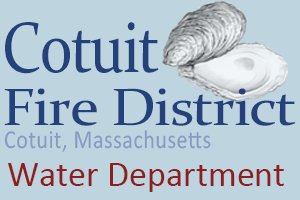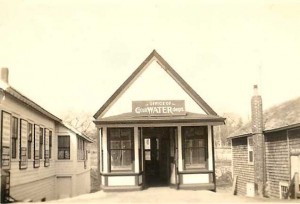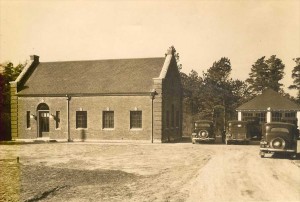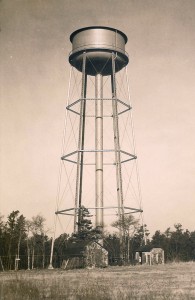Courtesy: Historical Society of Santuit and Cotuit
Written by: GORDON M. BROWNE, JR., July 14, 1967
Plans for developing a water department within the Fire District were talked about early in its history, but it was not until the special meeting of February 15, 1935, that $500 was appropriated to permit the Prudential Committee to employ engineers to make plans and estimates for a water department. Calvin D. Crawford, Ernest 0. Dottridge, and Burleigh Savery seem to have been the moving spirits behind the proposal, though others were undoubtedly involved. Support for the idea was far from unanimous, that first appropriation being approved only 19 to 9.
Though an article was introduced into the warrant of the 1935 Annual Meeting to establish a water system, the Prudential Committee asked for and was granted a continuance of that article to a future date. . Meanwhile, special enabling legislation was introduced in the Massachusetts legislature. At the Annual Meeting in 1936, the voters voted to accept Chapter 244 of the Acts of 1935, entitled “An Act authorizing the Cotuit Fire District to supply itself and its inhabitants with water for the extinguishment of fires and for domestic use.” The system was to be built as a PWA project, but guarantees of federal funds were slow taming through. An article calling for the election of water commissioners was, therefore, tabled, and the Prudential Committee was instructed to call a special District meeting when such guarantees were forthcoming.
At a special meeting on February 3, 1936, unanimous approval was given to the construction of the water system. Kenneth Turner, William H. Perry, and E. Ormand Dottridge, Jr. were elected the first water commissioners, and they and the Prudential Committee were authorized to proceed with construction of the project. $164,650 was voted for the purpose, of which only $650 was to be raised that year by taxation; $72,000 was to come from the federal government as a PWA project grant, and $92,000 was to be borrowed on a 30 year loan, a loan which has been finally paid off only with in the past year.
The first water service to an individual dwelling was connected in December, 1936, the water coming from the well field north of route 28 in Santuit. Within a year there were 114 services in use, most of them using less than the 40,000 gallons for which the minimum charge of $24 was paid. That minimum charge continues up to the present, though charges for use beyond the 40,000 gallons have been modified several times. In its first full year of operation the water department pumped 14,318,200 gallons of water. Its largest week was August 1- 7 when 860,400 gallons were pumped. It is interesting to compare these figures with those for a recent year, such as 1963 when 66,656,000 gallons were pumped and when 5,072,200 gallons were pumped in the week of July 1-7. William H. Perry, Jr., as the first superintendent of the water department, became the District’s first full-time employee. Even now in 1967, the Superintendent and Assistant Superintendent of the Water Department are the only full-time employees of the District, an example of restraint in bureaucratic expansion which other levels of government might be encouraged to consider.
Acquisition of large tracts of land for public purposes is always difficult, and there were problems about acquiring the first well field and water shed area. Typically, a very small piece of acre was the problem and involved a law suit which was several years being settled. The District immediately began a program of water shed development and protection on the rest of its property, planting some 4700 seedlings over a four year period. Though a number of these trees were subsequently stolen, especially at Christmas time, this early planning and work has helped substantially to protect Cotuit’s pure water supply.
With the opening of the amphibious engineers training camp off Old Post Road in 1942, the Water Commissioners were authorized to enter into arrangements with the Federal authorities for the installation of additional wells and the extension of water mains along Old Post Road to Camp Candoit. This was done at no expense to the District.
1950 was an especially strenuous year for the Water Department. The Kelly Corporation of Arlington, Massachusetts, proposed to build 59 small homes in Cotuit and sought to have them supplied with village water. This came at a time when engineers were warning that the Water Department was already over extended and needed additional water supplies. Opposition to the Kelly development was widespread and vocal in the community. Resolutions were passed opposing it, and letters were written to state and federal officers to try to block it. An appropriation to extend the water mains into the development area was voted down. The Kelly Corporation then offered to install all mains, hydrants, and service connections according to District specifications and inspection and then to give them to the District if they could have water. The Commissioners refused this offer. Finally a representative of the Kelly Corporation asked for water service at his development home, was refused, and brought suit to get it. Interested individuals paid the District’s legal fees, and the Commissioners won the case. Instead of buildings 59 houses, the Kelly Corporation built 41, each with its own water supply system.
This episode was surely one of the most controversial in District history. Some persons point out that by its firm resistance to supplying water to the development, the District forced a 30% reduction in the number of houses actually built. On the other hand, many people, even among those who opposed the development, point out that the District could have been receiving water revenue all these years from those homes, could have had better fire protection with water in that area, and could have had the whole installation free instead of having to pay for it piece-meal through the years as extensions are built with tax money and owner guarantees. The only certainty is that, rightly or wrongly, the District officers acted in what they conceived to be the best interests of the District. Fortunately, any objective view of the history of the District shows this always to have been true.
The following year, the District voted the necessary expansion of water supplies, and the sub-station and well field off Main Street were built. The same year the Commissioners reported that they were considering fluoridating Cotuit water, but this was never done, and the water flowing from Cotuit taps remains untreated in any way.
In 1956 a second elevated tank, this one near the new school, was authorized. Finally, in 1962 and 1963, funds were appropriated for a third well field and pumping station, which gives enough strength to the Cotuit water system so that it should provide amply for village needs for many years to come.
One of the major remaining problems for the Water Department is the most equitable way to continue the extension of mains until the whole District is covered. In the past, short extensions have been provided from tax money and larger ones by a guarantee or joint payment plan with the customer. As an effort is made to carry water beyond the center of the village, each of these plans raises problems. At the time of the writing of this history, the Commissioners were again wrestling with the problem of finding a way to provide extensions with fairness to water customers and to the District alike. Meanwhile, the demand for good, pure Cotuit water grows each year.
Water Commissioners
| Kenneth Turner | 1936-1969 |
| William H. Perry | 1936-1951 |
| Ernest O. Dottridge, Jr. | 1936-1951 |
| George C. Campbell | 1951-1951 (resigned) |
| I. Louis Campbell | 1951-1952 |
| William G. Ball | 1951-1959 |
| Thomas Rennie | 1952-1960 |
| Edward W. Moore | 1959-1971 |
| Philip Brackett | 1960-1966 |
| F. Maynard Gifford, Jr. | 1966-1975 |
| Joseph Hallett | 1970-1976 |
| James E. Downey | 1971-1975 |
| James P. Souza | 1975-1983 |
| Harry A. Ashley | 1975-1978, 1980-1981 |
| James R. Irwin | 1976-1980 (deceased) |
| Richard S. Knowlton | 1978-1980 (resigned) |
| David Pina | 1980-1987 |
| William O. Wool | 1981-1988 |
| Paul H. Wiggins | 1983-1992 |
| Marion McConnell | 1987-1990 |
| John N. Anderson | 1988-1999 (resigned) |
| Susan G. Rask | 1990-1992 (resigned) |
| John A. Thomas | 1992-2005 |
| Gaetano G. Calise, Jr. | 1992-2013 |
| Frederick Kiely | 1999-2015 |
| Theodore M. Barnicle | 2005-2017 |
| Donald Campbell | 2013-2019 |
| Victor Mastro | 2015-2018 |
| Thomas Hoppensteadt | 2017-2023 |
| Mark Robinson | 2018-present |
| Scott Horsley | 2019-present |
| David Churbuck | 2023-present |
Superintendents
| William H. Perry, Jr. | 1936-1946 |
| Stanley W. Turner | 1946-1950 |
| George Gardiner | 1950-1954 |
| F. Maynard Gifford | 1954-1966 |
| Earle McDowell | 1966-1977 |
| Charles Medchill | 1977-1986 |
| Leonard Mendes | 1986-2001 |
| Kenneth Ventura | 2001-2007 |
| Christopher Wiseman | 2007-present |



